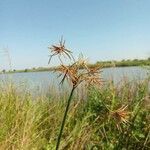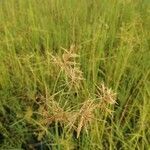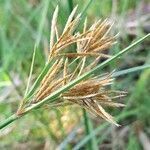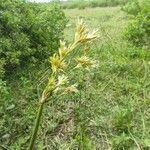A herb. It is an almost leafless sedge. It keeps growing from year to year and is erect. The stems are 1.2 m tall and pithy. The stems are about 1 cm thick. They are cylinder shaped and pale yellow. The flowering stalk has fine drooping branches. It has black tubers. They have a lavender smell.
A robust, leafless, perennial herb, up to 1.6 m high. Involucral bracts scale-like, up to 15 mm long. Leaf sheaths loose, straw-coloured, purple or blackish, ending in a triangular limb. Glumes reddish brown or straw-coloured.
The only species of Cyperus to have a round leafless pithy stem which on drying appears articulated
Rays slender bearing clusters of cigar-shaped spikelets





